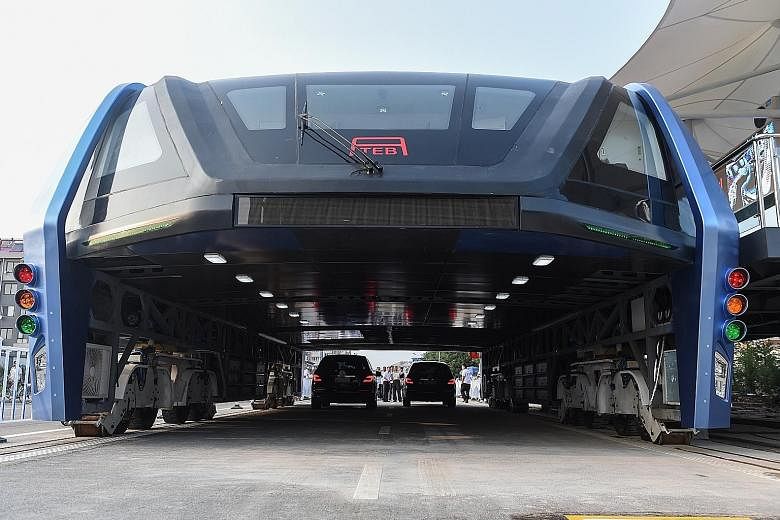BEIJING • Experts and netizens are casting doubts on the feasibility of a futuristic bus project that grabbed international headlines this week.
Soon after the inaugural test run of the so-called "straddling bus" in Qinhuangdao, a seaside city in northern Hebei province, on Tuesday, Chinese media and netizens asked many questions: How would the bus negotiate turns? What about the many drivers who jump in and out of lanes? And what about vehicles like trucks that are too large to fit under the bus?
Turning at broad intersections would not be a problem, said Mr Song Youzhou, designer of the Transit Elevated Bus (TEB) that aims to reduce traffic congestion. The cars underneath the bus would come to a stop and wait while the bus turns.
"Underneath the bus, traffic lights will be coordinated with the traffic lights on the road so that cars are notified," he said.
Sensors would warn bigger vehicles like trucks not to go underneath the TEB, which allows only cars no more than 2m in height to pass through.
An animated video from the bus maker shows a bus model straddling two lanes of traffic while cars pass through its hollow underbelly. Warning sensors will ensure that cars keep clear of its wheels, Mr Song explained in one video.
During emergencies, commuters can escape via evacuation slides similar to those in planes, he said. The video also showed people being transferred in pod-like elevators to specially built elevated bus stops.
The bus would have four connected carriages and be able to carry 1,200 passengers, reported Xinhua news agency. It said that many Chinese cities as well as foreign countries are interested in the project.
Tuesday's test run involved just one carriage and was conducted on a 300m-long track. It was declared a success, but the controlled conditions hardly reflected the gnarled unpredictability of Chinese traffic, reported the New York Times.
Television news showed the bus, resembling a Goliath bug, edging forward down tracks while two cars nestled side by side underneath.
"I wanted to officially show people that this is entirely possible and that the bus can be up and running," Mr Song said in a telephone interview from Qinhuangdao.
"We were inspecting and testing the vehicle for a range of functions, like ignition, braking and other processes, to see if they all work together and there are no problems."
But a full trial run will not take place until the middle of next year in a city in central China, he said.
Mr Song first unveiled the concept at a Beijing exhibition in 2010, but doubts about the project led to the cancellation of a trial run. Sceptics say the bus is a magnificent example of a solution to a problem that is likely to create even more problems.
In comments carried by the state-run Global Times, Professor Yin Zhi, dean of the Urban Planning and Design Institute at Tsinghua University, said: "The idea of the road-straddling bus was shot down six years ago by a panel for its impracticality. Yet it was brought back to the public again."
Professor Sun Zhang, a rail expert at Shanghai Tongji University, noted that standing at 4.5m, the giant bus would not be able to pass under many existing overpasses.
"The question lies in how to provide electricity to the (the bus)," he said. The bus is fully powered on electricity and needs to be charged at regular intervals.
The Global Times newspaper even went as far as to warn that the project "could be a financial fraud".
It quoted a report by the National Business Daily which said that the company behind the TEB project has begun to raise money by distributing bonds under the auspices of Huaying Kailai, an asset management company.
The company has been attracting investors with projected return rates of 10 per cent to 13 per cent, the Beijing Business Today reported in November last year. The Contemporary Business View also found that the company's branch in Nanjing was suspected of illegal fund-raising last year, after it offered rates as high as 16 per cent.

